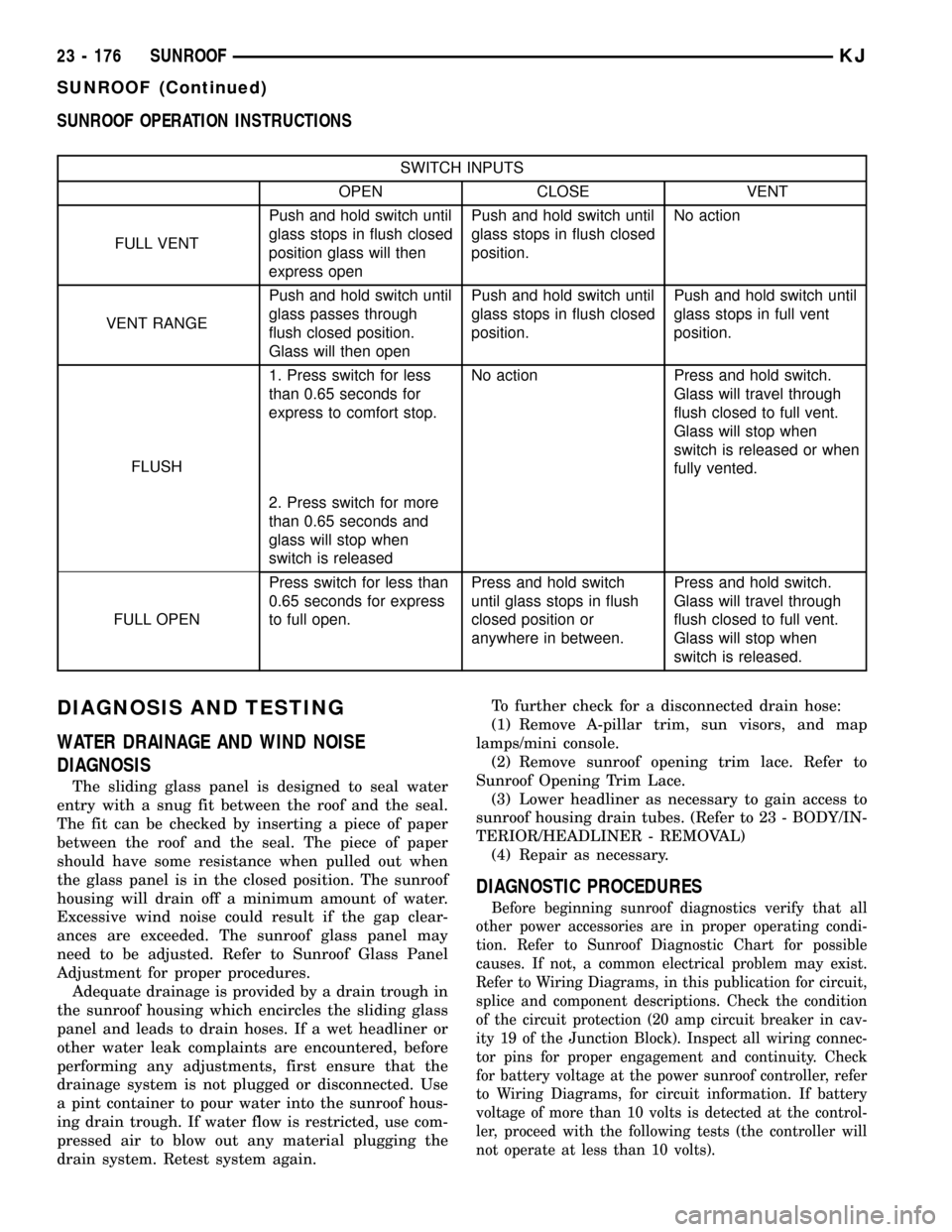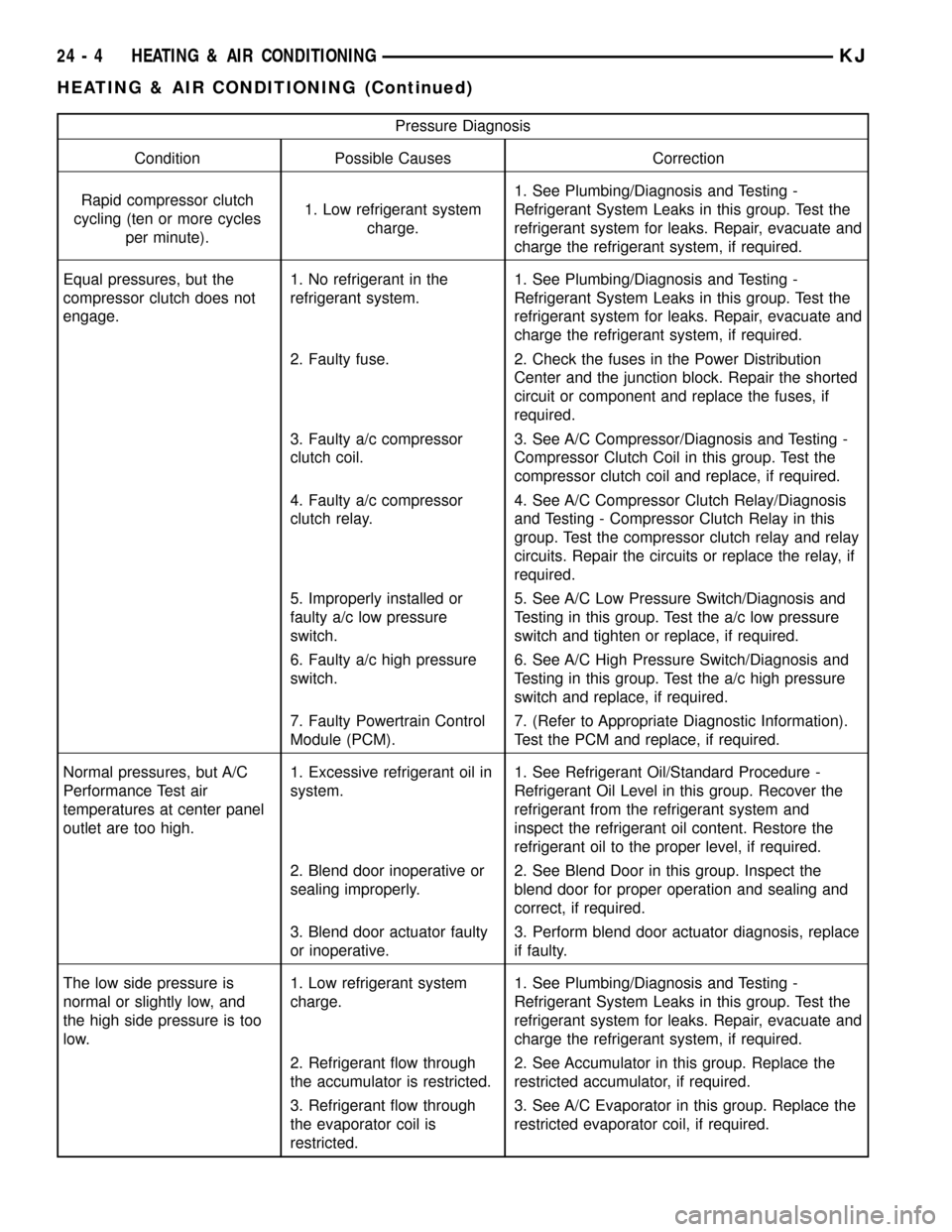2002 JEEP LIBERTY junction block
[x] Cancel search: junction blockPage 1614 of 1803

(1) Open the glove box.
(2) Remove the two striker screws and remove the
latch striker.
INSTALLATION
WARNING: ON VEHICLES EQUIPPED WITH AIR-
BAGS, DISABLE THE AIRBAG SYSTEM BEFORE
ATTEMPTING ANY STEERING WHEEL, STEERING
COLUMN, SEAT BELT TENSIONER, OR INSTRU-
MENT PANEL COMPONENT DIAGNOSIS OR SER-
VICE. DISCONNECT AND ISOLATE THE BATTERY
NEGATIVE (GROUND) CABLE, THEN WAIT TWO
MINUTES FOR THE AIRBAG SYSTEM CAPACITOR
TO DISCHARGE BEFORE PERFORMING FURTHER
DIAGNOSIS OR SERVICE. THIS IS THE ONLY SURE
WAY TO DISABLE THE AIRBAG SYSTEM. FAILURE
TO TAKE THE PROPER PRECAUTIONS COULD
RESULT IN ACCIDENTAL AIRBAG DEPLOYMENT
AND POSSIBLE PERSONAL INJURY.
(1) Install the striker and install the two screws.
(2) Loosen the screws to adjust if necessary.
INSTRUMENT PANEL
ASSEMBLY
REMOVAL
WARNING: ON VEHICLES EQUIPPED WITH AIR-
BAGS, DISABLE THE AIRBAG SYSTEM BEFORE
ATTEMPTING ANY STEERING WHEEL, STEERING
COLUMN, OR INSTRUMENT PANEL COMPONENT
DIAGNOSIS OR SERVICE. DISCONNECT AND ISO-
LATE THE BATTERY NEGATIVE (GROUND) CABLE,
THEN WAIT TWO MINUTES FOR THE AIRBAG SYS-
TEM CAPACITOR TO DISCHARGE BEFORE PER-
FORMING FURTHER DIAGNOSIS OR SERVICE. THIS
IS THE ONLY SURE WAY TO DISABLE THE AIRBAG
SYSTEM. FAILURE TO TAKE THE PROPER PRE-
CAUTIONS COULD RESULT IN ACCIDENTAL AIR-
BAG DEPLOYMENT AND POSSIBLE PERSONAL
INJURY.
NOTE: Before starting this procedure, be certain to
turn the steering wheel until the front wheels are in
the straight-ahead position.(1) Disconnect and isolate the battery negative
cable.
(2) Remove the instrument panel top cover. (Refer
to 23 - BODY/INSTRUMENT PANEL/INSTRUMENT
PANEL TOP COVER - REMOVAL)
(3) Remove the speakers.
(4) Remove the floor console. (Refer to 23 - BODY/
INTERIOR/FLOOR CONSOLE - REMOVAL)
(5) Remove the radio. (Refer to 8 - ELECTRICAL/
AUDIO/RADIO - REMOVAL)
(6) Remove the four nuts and remove the center
support bracket. (Fig. 6)
(7) Remove the steering column. (Refer to 19 -
STEERING/COLUMN - REMOVAL)
(8) Remove the drivers side cowl trim cover. (Refer
to 23 - BODY/INTERIOR/COWL TRIM COVER -
REMOVAL)
(9) Disconnect the wire harness connector behind
the drivers side cowl trim cover.
(10) Disconnect the green and light blue wire har-
ness bulk connectors at the junction block. (Fig. 1)
(11) Disconnect the electrical connector at the
inner side of the pedal support bracket. (Fig. 2)
(12) Remove the two bolts at the front of the pedal
support bracket. (Fig. 2)
(13) Remove the two bolts from the bottom side of
the pedal support bracket. (Fig. 2)
Fig. 1 JUNCTION BLOCK CONNECTORS
1 - ELECTRICAL CONNECTOR
2 - ELECTRICAL CONNECTOR
3 - PEDAL SUPPORT BRACKET
4 - JUNCTION BLOCK
KJINSTRUMENT PANEL 23 - 149
GLOVE BOX LATCH STRIKER (Continued)
Page 1617 of 1803

(8) Install the two roll down bracket bolts at the
right cowl side panel and tighten to 54 N´m (40 ft.
lbs.).
(9) Install the HVAC mounting bolt at the lower
outside corner of the glove box opening and tighten
to 6 N´m (55 in. lbs.).
(10) Install the HVAC mounting bolt above the
glove box striker.
(11) Install the passenger side trim bezel. (Refer to
23 - BODY/INSTRUMENT PANEL/INSTRUMENT
PANEL PASSENGER SIDE BEZEL - INSTALLA-
TION)
(12) Install the passenger side cowl trim cover.
(Refer to 23 - BODY/INTERIOR/COWL TRIM
COVER - INSTALLATION)
(13) Install the glove box. (Refer to 23 - BODY/IN-
STRUMENT PANEL/GLOVE BOX - INSTALLA-
TION)
NOTE: Do not push or pull bracket. Tighten at the
rest position.
(14) Install the two roll down bracket bolts at the
drivers cowl side panel and tighten to 54 N´m (40 ft.
lbs.).
(15) Install the two bolts at the bottom side of the
pedal support bracket.
(16) Install the two bolts at the front of the pedal
support bracket.
(17) Connect the electrical connector at the inner
side of the pedal support bracket.
(18) Connect the wiring harness electrical connec-
tors at the junction block.
(19) Connect the wire harness electrical connector
behind the drivers side cowl trim cover.
(20) Install the left cowl trim cover. (Refer to 23 -
BODY/INTERIOR/COWL TRIM COVER - INSTAL-
LATION)
(21) Install the steering column. (Refer to 19 -
STEERING/COLUMN - INSTALLATION)
(22) Install the two HVAC mounting bolts behind
the center trim.
(23) Install the ground strap and bolt and connect
the restraint module electrical connector.
(24) Install the center support bracket and hold it
tight against the instrument panel.
(25) Tighten the lower nuts to 23 N´m (17 ft. lbs.).
(26) Tighten the upper bracket nuts to 23 N´m (17
ft. lbs.).
(27) Install the radio. (Refer to 8 - ELECTRICAL/
AUDIO/RADIO - INSTALLATION)
(28) Install the floor console. (Refer to 23 - BODY/
INTERIOR/FLOOR CONSOLE - INSTALLATION)
(29) Install the speakers.
(30) Install the instrument panel top cover. (Refer
to 23 - BODY/INSTRUMENT PANEL/INSTRUMENT
PANEL TOP COVER - INSTALLATION)(31) Reconnect the battery ground cable.
INSTRUMENT PANEL TOP
COVER
REMOVAL
WARNING: ON VEHICLES EQUIPPED WITH AIR-
BAGS, DISABLE THE AIRBAG SYSTEM BEFORE
ATTEMPTING ANY STEERING WHEEL, STEERING
COLUMN, SEAT BELT TENSIONER, OR INSTRU-
MENT PANEL COMPONENT DIAGNOSIS OR SER-
VICE. DISCONNECT AND ISOLATE THE BATTERY
NEGATIVE (GROUND) CABLE, THEN WAIT TWO
MINUTES FOR THE AIRBAG SYSTEM CAPACITOR
TO DISCHARGE BEFORE PERFORMING FURTHER
DIAGNOSIS OR SERVICE. THIS IS THE ONLY SURE
WAY TO DISABLE THE AIRBAG SYSTEM. FAILURE
TO TAKE THE PROPER PRECAUTIONS COULD
RESULT IN ACCIDENTAL AIRBAG DEPLOYMENT
AND POSSIBLE PERSONAL INJURY.
(1) Remove the a-pillar trim. (Refer to 23 - BODY/
INTERIOR/A-PILLAR TRIM AND GRAB HANDLE -
REMOVAL)
(2) Using a trim stick C-4755 or equivalent,
release the attachment clips and remove the top
cover. (Fig. 7)
Fig. 7 INSTRUMENT PANEL COVERS
1 - SIDE COVER
2 - INSTRUMENT PANEL ASSEMBLY
3 - TOP COVER
23 - 152 INSTRUMENT PANELKJ
INSTRUMENT PANEL ASSEMBLY (Continued)
Page 1641 of 1803

SUNROOF OPERATION INSTRUCTIONS
SWITCH INPUTS
OPEN CLOSE VENT
FULL VENTPush and hold switch until
glass stops in flush closed
position glass will then
express openPush and hold switch until
glass stops in flush closed
position.No action
VENT RANGEPush and hold switch until
glass passes through
flush closed position.
Glass will then openPush and hold switch until
glass stops in flush closed
position.Push and hold switch until
glass stops in full vent
position.
FLUSH1. Press switch for less
than 0.65 seconds for
express to comfort stop.No action Press and hold switch.
Glass will travel through
flush closed to full vent.
Glass will stop when
switch is released or when
fully vented.
2. Press switch for more
than 0.65 seconds and
glass will stop when
switch is released
FULL OPENPress switch for less than
0.65 seconds for express
to full open.Press and hold switch
until glass stops in flush
closed position or
anywhere in between.Press and hold switch.
Glass will travel through
flush closed to full vent.
Glass will stop when
switch is released.
DIAGNOSIS AND TESTING
WATER DRAINAGE AND WIND NOISE
DIAGNOSIS
The sliding glass panel is designed to seal water
entry with a snug fit between the roof and the seal.
The fit can be checked by inserting a piece of paper
between the roof and the seal. The piece of paper
should have some resistance when pulled out when
the glass panel is in the closed position. The sunroof
housing will drain off a minimum amount of water.
Excessive wind noise could result if the gap clear-
ances are exceeded. The sunroof glass panel may
need to be adjusted. Refer to Sunroof Glass Panel
Adjustment for proper procedures.
Adequate drainage is provided by a drain trough in
the sunroof housing which encircles the sliding glass
panel and leads to drain hoses. If a wet headliner or
other water leak complaints are encountered, before
performing any adjustments, first ensure that the
drainage system is not plugged or disconnected. Use
a pint container to pour water into the sunroof hous-
ing drain trough. If water flow is restricted, use com-
pressed air to blow out any material plugging the
drain system. Retest system again.To further check for a disconnected drain hose:
(1) Remove A-pillar trim, sun visors, and map
lamps/mini console.
(2) Remove sunroof opening trim lace. Refer to
Sunroof Opening Trim Lace.
(3) Lower headliner as necessary to gain access to
sunroof housing drain tubes. (Refer to 23 - BODY/IN-
TERIOR/HEADLINER - REMOVAL)
(4) Repair as necessary.
DIAGNOSTIC PROCEDURES
Before beginning sunroof diagnostics verify that all
other power accessories are in proper operating condi-
tion. Refer to Sunroof Diagnostic Chart for possible
causes. If not, a common electrical problem may exist.
Refer to Wiring Diagrams, in this publication for circuit,
splice and component descriptions. Check the condition
of the circuit protection (20 amp circuit breaker in cav-
ity 19 of the Junction Block). Inspect all wiring connec-
tor pins for proper engagement and continuity. Check
for battery voltage at the power sunroof controller, refer
to Wiring Diagrams, for circuit information. If battery
voltage of more than 10 volts is detected at the control-
ler, proceed with the following tests (the controller will
not operate at less than 10 volts).
23 - 176 SUNROOFKJ
SUNROOF (Continued)
Page 1656 of 1803

Pressure Diagnosis
Condition Possible Causes Correction
Rapid compressor clutch
cycling (ten or more cycles
per minute).1. Low refrigerant system
charge.1. See Plumbing/Diagnosis and Testing -
Refrigerant System Leaks in this group. Test the
refrigerant system for leaks. Repair, evacuate and
charge the refrigerant system, if required.
Equal pressures, but the
compressor clutch does not
engage.1. No refrigerant in the
refrigerant system.1. See Plumbing/Diagnosis and Testing -
Refrigerant System Leaks in this group. Test the
refrigerant system for leaks. Repair, evacuate and
charge the refrigerant system, if required.
2. Faulty fuse. 2. Check the fuses in the Power Distribution
Center and the junction block. Repair the shorted
circuit or component and replace the fuses, if
required.
3. Faulty a/c compressor
clutch coil.3. See A/C Compressor/Diagnosis and Testing -
Compressor Clutch Coil in this group. Test the
compressor clutch coil and replace, if required.
4. Faulty a/c compressor
clutch relay.4. See A/C Compressor Clutch Relay/Diagnosis
and Testing - Compressor Clutch Relay in this
group. Test the compressor clutch relay and relay
circuits. Repair the circuits or replace the relay, if
required.
5. Improperly installed or
faulty a/c low pressure
switch.5. See A/C Low Pressure Switch/Diagnosis and
Testing in this group. Test the a/c low pressure
switch and tighten or replace, if required.
6. Faulty a/c high pressure
switch.6. See A/C High Pressure Switch/Diagnosis and
Testing in this group. Test the a/c high pressure
switch and replace, if required.
7. Faulty Powertrain Control
Module (PCM).7. (Refer to Appropriate Diagnostic Information).
Test the PCM and replace, if required.
Normal pressures, but A/C
Performance Test air
temperatures at center panel
outlet are too high.1. Excessive refrigerant oil in
system.1. See Refrigerant Oil/Standard Procedure -
Refrigerant Oil Level in this group. Recover the
refrigerant from the refrigerant system and
inspect the refrigerant oil content. Restore the
refrigerant oil to the proper level, if required.
2. Blend door inoperative or
sealing improperly.2. See Blend Door in this group. Inspect the
blend door for proper operation and sealing and
correct, if required.
3. Blend door actuator faulty
or inoperative.3. Perform blend door actuator diagnosis, replace
if faulty.
The low side pressure is
normal or slightly low, and
the high side pressure is too
low.1. Low refrigerant system
charge.1. See Plumbing/Diagnosis and Testing -
Refrigerant System Leaks in this group. Test the
refrigerant system for leaks. Repair, evacuate and
charge the refrigerant system, if required.
2. Refrigerant flow through
the accumulator is restricted.2. See Accumulator in this group. Replace the
restricted accumulator, if required.
3. Refrigerant flow through
the evaporator coil is
restricted.3. See A/C Evaporator in this group. Replace the
restricted evaporator coil, if required.
24 - 4 HEATING & AIR CONDITIONINGKJ
HEATING & AIR CONDITIONING (Continued)
Page 1664 of 1803

A/C COMPRESSOR CLUTCH
DESCRIPTION - 3.7L and 2.4L
The compressor clutch assembly consists of a sta-
tionary electromagnetic coil, a rotor bearing and
rotor assembly, and a clutch plate (Fig. 1). The elec-
tromagnetic coil unit and the rotor bearing and rotor
assembly are each retained on the nose of the com-
pressor front housing with snap rings. The clutch
plate is keyed to the compressor shaft and secured
with a nut. These components provide the means to
engage and disengage the compressor from the
engine serpentine accessory drive belt.
OPERATION - 3.7L and 2.4L
When the clutch coil is energized, it magnetically
draws the clutch into contact with the rotor and
drives the compressor shaft. When the coil is not
energized, the rotor freewheels on the clutch rotor
bearing, which is part of the rotor. The compressor
clutch and coil are the only serviced parts on the
compressor.
The compressor clutch engagement is controlled by
several components: the A/C Heater mode control
switch, the A/C low pressure switch, the A/C high
pressure switch, the compressor clutch relay, and the
Powertrain Control Module (PCM). The PCM may
delay compressor clutch engagement for up to thirty
seconds. Refer to Electronic Control Modules for
more information on the PCM controls.
DIAGNOSIS AND TESTING - A/C COMPRESSOR
CLUTCH COIL
For circuit descriptions and diagrams, (Refer to
Appropriate Wiring Information). The battery must
be fully-charged before performing the following
tests. Refer to Battery for more information.
(1) Connect an ammeter (0 to 10 ampere scale) in
series with the clutch coil terminal. Use a voltmeter
(0 to 20 volt scale) with clip-type leads for measuring
the voltage across the battery and the compressor
clutch coil.
(2) With the A/C Heater mode control switch in
any A/C mode, and the blower motor switch in the
lowest speed position, start the engine and run it at
normal idle.
(3) The compressor clutch coil voltage should read
within 0.2 volts of the battery voltage. If there is
voltage at the clutch coil, but the reading is not
within 0.2 volts of the battery voltage, test the clutch
coil feed circuit for excessive voltage drop and repair
as required. If there is no voltage reading at the
clutch coil, use a DRB IIItscan tool and (Refer to
Appropriate Diagnostic Information) for testing of the
compressor clutch circuit and PCM control. The fol-
lowing components must be checked and repaired as
required before you can complete testing of the clutch
coil:
²Fuses in the junction block and the Power Dis-
tribution Center (PDC)
²A/C heater mode control switch
²Compressor clutch relay
²A/C high pressure switch
²A/C low pressure switch
²Powertrain Control Module (PCM).
(4) The compressor clutch coil is acceptable if the
current draw measured at the clutch coil is 2.0 to 3.9
amperes with the electrical system voltage at 11.5 to
12.5 volts. This should only be checked with the work
area temperature at 21É C (70É F). If system voltage
is more than 12.5 volts, add electrical loads by turn-
ing on electrical accessories until the system voltage
drops below 12.5 volts.
(a) If the clutch coil current reading is four
amperes or more, the coil is shorted and should be
replaced.
(b) If the clutch coil current reading is zero, the
coil is open and should be replaced.
STANDARD PROCEDURE - A/C COMPRESSOR
CLUTCH BREAK-IN
After a new compressor clutch has been installed,
cycle the compressor clutch approximately twenty
times (five seconds on, then five seconds off). During
this procedure, set the A/C Heater control to the
Recirculation Mode, the blower motor switch in the
highest speed position, and the engine speed at 1500
Fig. 1 COMPRESSOR CLUTCH - TYPICAL
1 - CLUTCH PLATE
2 - NOT USED ON KJ
3 - ROTOR
4 - COIL
5 - CLUTCH SHIMS
6 - SNAP RING
7 - SNAP RING
24 - 12 CONTROLSKJ
Page 1668 of 1803

(2) Resistance between terminals 85 and 86 (elec-
tromagnet) should be 67.5 to 82.5 ohms. If OK, go to
Step 3. If not OK, replace the faulty relay.
(3) Connect a battery to terminals 85 and 86.
There should now be continuity between terminals
30 and 87, and no continuity between terminals 87A
and 30. If OK, see Relay Circuit Test. If not OK,
replace the faulty relay.
RELAY CIRCUIT TEST
For circuit descriptions and diagrams, (Refer to
Appropriate Wiring Information).
(1) The relay common feed terminal cavity (30) is
connected to fused battery feed. There should be bat-
tery voltage at the cavity for relay terminal 30 at all
times. If OK, go to Step 2. If not OK, repair the open
circuit to the fuse in the PDC as required.
(2) The relay normally closed terminal (87A) is not
used in this application. Go to Step 3.
(3) The relay normally open terminal cavity (87) is
connected to the compressor clutch coil. There should
be continuity between this cavity and the A/C com-
pressor clutch relay output circuit cavity of the com-
pressor clutch coil wire harness connector. If OK, go
to Step 4. If not OK, repair the open circuit as
required.
(4) The relay coil battery terminal (86) is con-
nected to the fused ignition switch output (run/start)circuit. There should be battery voltage at the cavity
for relay terminal 86 with the ignition switch in the
On position. If OK, go to Step 5. If not OK, repair the
open circuit to the fuse in the junction block as
required.
(5) The coil ground terminal cavity (85) is switched
to ground through the Powertrain Control Module
(PCM). There should be continuity between this cav-
ity and the A/C compressor clutch relay control cir-
cuit cavity of the PCM wire harness connector C
(gray) at all times. If not OK, repair the open circuit
as required.
REMOVAL
(1) Disconnect and isolate the battery negative
cable.
(2) Remove the cover from the Power Distribution
Center (PDC).
(3) Refer to the label on the PDC for compressor
clutch relay identification and location.
(4) Unplug the compressor clutch relay from the
PDC.
INSTALLATION
(1) Install the compressor clutch relay by aligning
the relay terminals with the cavities in the PDC and
pushing the relay firmly into place.
(2) Install the PDC cover.
(3) Connect the battery negative cable.
(4) Test the relay operation.
A/C HEATER CONTROL
DESCRIPTION
Both the heater-only and A/C heater systems use a
combination of mechanical, electrical, and vacuum
controls. These controls provide the vehicle operator
with a number of setting options to help control the
climate and comfort within the vehicle. Refer to the
owner's manual in the vehicle glove box for more
information on the features, use, and suggested oper-
ation of these controls.
The heater-only or A/C heater control panel is
located to the right of the instrument cluster on the
instrument panel. The control panel contains a rota-
ry-type temperature control knob, a rotary-type mode
control switch knob, and a rotary-type blower motor
speed switch knob. The control also has a push but-
ton to activate the rear window defogger.
The heater-only or A/C heater control panel cannot
be repaired. If faulty or damaged, the entire unit
must be replaced. The illumination lamps are avail-
able for service replacement.
Fig. 10 COMPRESSOR CLUTCH RELAY
30 - COMMON FEED
85 - COIL GROUND
86 - COIL BATTERY
87 - NORMALLY OPEN
87A - NORMALLY CLOSED
24 - 16 CONTROLSKJ
A/C COMPRESSOR CLUTCH RELAY (Continued)
Page 1673 of 1803

DIAGNOSIS AND TESTING - BLOWER MOTOR
RELAY
WARNING: ON VEHICLES EQUIPPED WITH AIR-
BAGS, DISABLE THE AIRBAG SYSTEM BEFORE
ATTEMPTING ANY STEERING WHEEL, STEERING
COLUMN, OR INSTRUMENT PANEL COMPONENT
DIAGNOSIS OR SERVICE. DISCONNECT AND ISO-
LATE THE BATTERY NEGATIVE (GROUND) CABLE,
THEN WAIT TWO MINUTES FOR THE AIRBAG SYS-
TEM CAPACITOR TO DISCHARGE BEFORE PER-
FORMING FURTHER DIAGNOSIS OR SERVICE. THIS
IS THE ONLY SURE WAY TO DISABLE THE AIRBAG
SYSTEM. FAILURE TO TAKE THE PROPER PRE-
CAUTIONS COULD RESULT IN AN ACCIDENTAL
AIRBAG DEPLOYMENT AND POSSIBLE PERSONAL
INJURY.
RELAY TEST
The blower motor relay (Fig. 15) is located in the
PDC which is located under the hood.. Remove the
relay from the PDC to perform the following tests:
(1) A relay in the de-energized position should
have continuity between terminals 87A and 30, and
no continuity between terminals 87 and 30. If OK, go
to Step 2. If not OK, replace the faulty relay.
(2) Resistance between terminals 85 and 86 (elec-
tromagnet) should be 60.7 to 80.3 ohms. If OK, go to
Step 3. If not OK, replace the faulty relay.
(3) Connect a battery to terminals 85 and 86.
There should now be continuity between terminals
30 and 87, and no continuity between terminals 87A
and 30. If OK, see the Relay Circuit Test. If not OK,
replace the faulty relay.
RELAY CIRCUIT TEST
For circuit descriptions and diagrams, (Refer to
Appropriate Wiring Information).
(1) The relay common feed terminal cavity (30) is
connected to fused battery feed directly from a fuse
in the Power Distribution Center (PDC), and should
be hot at all times. Check for battery voltage at the
connector cavity for relay terminal 30. If OK, go to
Step 2. If not OK, repair the open circuit to the PDC
fuse as required.
(2) The relay normally closed terminal cavity (87A)
is not used for this application. Go to Step 3.
(3) The relay normally open terminal cavity (87) is
connected to the blower motor. When the relay is
energized, terminal 87 is connected to terminal 30
and provides full battery current to the blower motor
feed circuit. There should be continuity between the
connector cavity for terminal 87 and the blower
motor at all times. If OK, go to Step 4. If not OK,
repair the open circuit to the blower motor as
required.
(4) The coil battery terminal cavity (86) is con-
nected to the ignition switch. When the ignition
switch is placed in the On position, fused ignition
switch output is directed from a fuse in the junction
block to the relay electromagnetic coil to energize the
relay. There should be battery voltage at the connec-
tor cavity for relay terminal 86 with the ignition
switch in the On position. If OK, go to Step 5. If not
OK, repair the open circuit to the junction block fuse
as required.
(5) The coil ground terminal cavity (85) is con-
nected to ground. This terminal supplies the ground
for the relay electromagnet coil. There should be con-
tinuity between the connector cavity for relay termi-
nal 85 and a good ground at all times. If not OK,
repair the open circuit as required.
REMOVAL
WARNING: ON VEHICLES EQUIPPED WITH AIR-
BAGS, DISABLE THE AIRBAG SYSTEM BEFORE
ATTEMPTING ANY STEERING WHEEL, STEERING
COLUMN, OR INSTRUMENT PANEL COMPONENT
DIAGNOSIS OR SERVICE. DISCONNECT AND ISO-
LATE THE BATTERY NEGATIVE (GROUND) CABLE,
THEN WAIT TWO MINUTES FOR THE AIRBAG SYS-
TEM CAPACITOR TO DISCHARGE BEFORE PER-
FORMING FURTHER DIAGNOSIS OR SERVICE. THIS
IS THE ONLY SURE WAY TO DISABLE THE AIRBAG
SYSTEM. FAILURE TO TAKE THE PROPER PRE-
CAUTIONS COULD RESULT IN AN ACCIDENTAL
AIRBAG DEPLOYMENT AND POSSIBLE PERSONAL
INJURY.
Fig. 15 BLOWER MOTOR RELAY
30 - COMMON FEED
85 - COIL GROUND
86 - COIL BATTERY
87 - NORMALLY OPEN
87A - NORMALLY CLOSED
KJCONTROLS 24 - 21
BLOWER MOTOR RELAY (Continued)
Page 1742 of 1803

BATTERY TRAY - OPERATION...........8F-21
BATTERY TRAY - REMOVAL............8F-21
BEAM INDICATOR - DESCRIPTION, HIGH . . 8J-22
BEAM INDICATOR - OPERATION, HIGH....8J-22
BEAM RELAY - DESCRIPTION,
HEADLAMP HIGH....................8L-33
BEAM RELAY - DESCRIPTION,
HEADLAMP LOW.....................8L-39
BEAM RELAY - DIAGNOSIS AND
TESTING, HEADLAMP HIGH............8L-34
BEAM RELAY - DIAGNOSIS AND
TESTING, HEADLAMP LOW.............8L-40
BEAM RELAY - INSTALLATION,
HEADLAMP HIGH....................8L-35
BEAM RELAY - INSTALLATION,
HEADLAMP LOW.....................8L-41
BEAM RELAY - OPERATION, HEADLAMP
HIGH..............................8L-33
BEAM RELAY - OPERATION, HEADLAMP
LOW ..............................8L-39
BEAM RELAY - REMOVAL, HEADLAMP
HIGH..............................8L-34
BEAM RELAY - REMOVAL, HEADLAMP
LOW ..............................8L-40
BEARING - FITTING - STANDARD
PROCEDURE, CONNECTING ROD.........9-40
BEARING - INSTALLATION, CLUTCH
RELEASE.............................6-6
BEARING - INSTALLATION, HUB...........2-9
BEARING - INSTALLATION, PILOT.........6-8
BEARING - REMOVAL, CLUTCH RELEASE . . . 6-6
BEARING - REMOVAL, HUB..............2-9
BEARING - REMOVAL, PILOT.............6-8
BEARING, FITTING - CONNECTING ROD....9-49
BEARING, FITTING - MAIN..............9-45
BEARINGS - INSTALLATION, AXLE . . . 3-102,3-38
BEARINGS - INSTALLATION,
DIFFERENTIAL CASE..........3-110,3-44,3-79
BEARINGS - REMOVAL, AXLE.......3-102,3-38
BEARINGS - REMOVAL, DIFFERENTIAL
CASE......................3-110,3-43,3-79
BEARING/SEAL - INSTALLATION, AXLE....3-67
BEARING/SEAL - REMOVAL, AXLE........3-66
BELT / CHAIN COVER(S) -
INSTALLATION, TIMING.................9-76
BELT / CHAIN COVER(S) - REMOVAL,
TIMING.............................9-74
BELT - DIAGNOSIS AND TESTING,
SERPENTINE DRIVE...................7-15
BELT & RETRACTOR - INSTALLATION,
FRONT SEAT........................8O-24
BELT & RETRACTOR - INSTALLATION,
REAR CENTER SEAT..................8O-33
BELT & RETRACTOR - INSTALLATION,
REAR OUTBOARD SEAT...............8O-34
BELT & RETRACTOR - REMOVAL, FRONT
SEAT ..............................8O-23
BELT & RETRACTOR - REMOVAL, REAR
CENTER SEAT.......................8O-32
BELT & RETRACTOR - REMOVAL, REAR
OUTBOARD SEAT....................8O-33
BELT BUCKLE - INSTALLATION, FRONT
SEAT ..............................8O-26
BELT BUCKLE - INSTALLATION, REAR
SEAT ..............................8O-35
BELT BUCKLE - REMOVAL, FRONT SEAT . . 8O-25
BELT BUCKLE - REMOVAL, REAR SEAT . . . 8O-34
BELT MOLDING - INSTALLATION, FRONT
DOOR OUTER......................23-186
BELT MOLDING - INSTALLATION, REAR
DOOR OUTER......................23-186
BELT MOLDING - REMOVAL, FRONT
DOOR OUTER......................23-186
BELT MOLDING - REMOVAL, REAR
DOOR OUTER......................23-186
BELT SWITCH - DESCRIPTION, SEAT.....8O-35
BELT SWITCH - OPERATION, SEAT.......8O-36
BELT TENSIONER - DESCRIPTION, SEAT . . 8O-36
BELT TENSIONER - OPERATION, SEAT....8O-36
BELT TURNING LOOP ADJUSTER -
INSTALLATION, SEAT
.................8O-38
BELT TURNING LOOP ADJUSTER -
REMOVAL, SEAT
.....................8O-37
BELTLINE WEATHERSTRIP -
INSTALLATION, SWING GATE
..........23-186
BELTLINE WEATHERSTRIP - REMOVAL,
SWING GATE
.......................23-186
BEZEL - INSTALLATION, CLUSTER
......23-147BEZEL - INSTALLATION, INSTRUMENT
PANEL CENTER.....................23-154
BEZEL - INSTALLATION, INSTRUMENT
PANEL PASSENGER SIDE.............23-154
BEZEL - INSTALLATION, SHIFT.........23-158
BEZEL - REMOVAL, CLUSTER..........23-147
BEZEL - REMOVAL, INSTRUMENT PANEL
CENTER...........................23-154
BEZEL - REMOVAL, INSTRUMENT PANEL
PASSENGER SIDE...................23-154
BEZEL - REMOVAL, SHIFT.............23-158
BEZELS - INSTALLATION, INSTRUMENT
PANEL DRIVER SIDE.................23-154
BEZELS - REMOVAL, INSTRUMENT
PANEL DRIVER SIDE.................23-153
BLADE - DESCRIPTION, FRONT WIPER . . . 8R-13
BLADE - DESCRIPTION, REAR WIPER....8R-39
BLADE - INSTALLATION, FRONT WIPER . . . 8R-14
BLADE - INSTALLATION, REAR WIPER....8R-40
BLADE - OPERATION, FRONT WIPER.....8R-14
BLADE - OPERATION, REAR WIPER......8R-39
BLADE - REMOVAL, FRONT WIPER......8R-14
BLADE - REMOVAL, REAR WIPER.......8R-40
BLEEDING - STANDARD PROCEDURE,
ABS BRAKE..........................5-33
BLEEDING - STANDARD PROCEDURE,
MANUAL.............................5-6
BLEEDING - STANDARD PROCEDURE,
MASTER CYLINDER...................5-24
BLEEDING - STANDARD PROCEDURE,
PRESSURE...........................5-5
BLEND DOOR - INSTALLATION..........24-35
BLEND DOOR - REMOVAL.............24-35
BLEND DOOR ACTUATOR -
INSTALLATION.......................24-20
BLEND DOOR ACTUATOR - REMOVAL....24-20
BLOCK - CLEANING, ENGINE............9-39
BLOCK - DESCRIPTION, ENGINE..........9-39
BLOCK - DESCRIPTION, JUNCTION....8W-97-4
BLOCK - DESCRIPTION, JUNCTION.......5-20
BLOCK - DIAGNOSIS AND TESTING,
JUNCTION........................8W-97-4
BLOCK - INSPECTION, ENGINE...........9-40
BLOCK - INSTALLATION, JUNCTION.......5-20
BLOCK - OPERATION, JUNCTION......8W-97-4
BLOCK - OPERATION, JUNCTION.........5-20
BLOCK - REMOVAL, JUNCTION...........5-20
BLOCKER - INSTALLATION, KNEE.......23-155
BLOCKER - REMOVAL, KNEE..........23-155
BLOWER MOTOR - DESCRIPTION.......24-30
BLOWER MOTOR - DIAGNOSIS AND
TESTING...........................24-30
BLOWER MOTOR - INSTALLATION.......24-31
BLOWER MOTOR - OPERATION.........24-30
BLOWER MOTOR - REMOVAL...........24-30
BLOWER MOTOR RELAY - DESCRIPTION . . 24-20
BLOWER MOTOR RELAY - DIAGNOSIS
AND TESTING.......................24-21
BLOWER MOTOR RELAY -
INSTALLATION.......................24-22
BLOWER MOTOR RELAY - OPERATION . . . 24-20
BLOWER MOTOR RELAY - REMOVAL.....24-21
BLOWER MOTOR RESISTOR -
DESCRIPTION.......................24-22
BLOWER MOTOR RESISTOR -
DIAGNOSIS AND TESTING.............24-22
BLOWER MOTOR RESISTOR -
INSTALLATION.......................24-22
BLOWER MOTOR RESISTOR -
OPERATION.........................24-22
BLOWER MOTOR RESISTOR - REMOVAL . . 24-22
BLOWER MOTOR SWITCH -
DESCRIPTION.......................24-23
BLOWER MOTOR SWITCH - DIAGNOSIS
AND TESTING.......................24-23
BLOWER MOTOR SWITCH -
INSTALLATION.......................24-23
BLOWER MOTOR SWITCH - OPERATION . . 24-23
BLOWER MOTOR SWITCH - REMOVAL . . . 24-23
BODY - ASSEMBLY, VALVE............21-176
BODY & CABLE - DESCRIPTION,
ANTENNA...........................8A-4
BODY & CABLE - INSTALLATION,
ANTENNA
...........................8A-6
BODY & CABLE - OPERATION, ANTENNA
. . . 8A-5
BODY & CABLE - REMOVAL, ANTENNA
....8A-6
BODY - CLEANING, VALVE
............21-175
BODY - DESCRIPTION, THROTTLE
.......14-43BODY - DESCRIPTION, VALVE..........21-171
BODY - DISASSEMBLY, VALVE.........21-173
BODY - INSPECTION, VALVE...........21-175
BODY - INSTALLATION, THROTTLE.......14-44
BODY - INSTALLATION, VALVE.........21-177
BODY - OPERATION, THROTTLE.........14-43
BODY - OPERATION, VALVE...........21-171
BODY - REMOVAL, THROTTLE..........14-43
BODY - REMOVAL, VALVE.............21-172
BODY AND CABLE - DIAGNOSIS AND
TESTING, ANTENNA...................8A-5
BODY CONTROL MODULE -
DESCRIPTION........................8E-2
BODY CONTROL MODULE - DIAGNOSIS
AND TESTING........................8E-7
BODY CONTROL MODULE -
INSTALLATION........................8E-7
BODY CONTROL MODULE - OPERATION . . . 8E-5
BODY CONTROL MODULE - REMOVAL.....8E-7
BODY LUBRICATION - STANDARD
PROCEDURE.........................23-3
BODY SIDE MOLDINGS - INSTALLATION . 23-140
BODY SIDE MOLDINGS - REMOVAL.....23-140
BODY, SPECIAL TOOLS.................23-5
BOOSTER - DESCRIPTION, POWER
BRAKE..............................5-21
BOOSTER - DIAGNOSIS AND TESTING,
MASTER CYLINDER/POWER.........5-21,5-24
BOOSTER - INSTALLATION, POWER
BRAKE..............................5-23
BOOSTER - OPERATION, POWER BRAKE . . . 5-21
BOOSTER - REMOVAL, POWER BRAKE....5-22
BOOT - INSTALLATION, 4WD FLOOR
SHIFT.............................23-156
BOOT - REMOVAL, 4WD FLOOR SHIFT . . . 23-156
BORE HONING - STANDARD
PROCEDURE, CYLINDER................9-39
BOX - INSTALLATION, GLOVE..........23-148
BOX - REMOVAL, GLOVE.............23-148
BOX LATCH - INSTALLATION, GLOVE....23-148
BOX LATCH - REMOVAL, GLOVE........23-148
BOX LATCH STRIKER - INSTALLATION,
GLOVE............................23-149
BOX LATCH STRIKER - REMOVAL,
GLOVE............................23-148
B-PILLAR LOWER TRIM - INSTALLATION . 23-157
B-PILLAR LOWER TRIM - REMOVAL....23-157
B-PILLAR UPPER TRIM - INSTALLATION . 23-158
B-PILLAR UPPER TRIM - REMOVAL.....23-157
BRACKET - INSTALLATION, CLEVIS.......2-13
BRACKET - INSTALLATION, HOOD AJAR
SWITCH............................8Q-13
BRACKET - INSTALLATION, PASSENGER
AIRBAG MOUNTING..................8O-31
BRACKET - INSTALLATION, REARVIEW
MIRROR SUPPORT..................23-161
BRACKET - REMOVAL, CLEVIS...........2-13
BRACKET - REMOVAL, HOOD AJAR
SWITCH............................8Q-13
BRACKET - REMOVAL, PASSENGER
AIRBAG MOUNTING..................8O-31
BRAKE - ADJUSTMENT, REAR DRUM......5-12
BRAKE - DESCRIPTION, PARKING........5-29
BRAKE - DESCRIPTION, REAR DRUM.....5-10
BRAKE - INSTALLATION, CONTROLLER
ANTILOCK..........................8E-10
BRAKE - OPERATION, PARKING..........5-29
BRAKE - OPERATION, REAR DRUM.......5-11
BRAKE - REMOVAL, CONTROLLER
ANTILOCK..........................8E-10
BRAKE BLEEDING - STANDARD
PROCEDURE, ABS.....................5-33
BRAKE BOOSTER - DESCRIPTION,
POWER.............................5-21
BRAKE BOOSTER - INSTALLATION,
POWER.............................5-23
BRAKE BOOSTER - OPERATION, POWER . . . 5-21
BRAKE BOOSTER - REMOVAL, POWER....5-22
BRAKE CALIPER ADAPTER -
INSTALLATION, DISC...................5-18
BRAKE CALIPER ADAPTER - REMOVAL,
DISC...............................5-18
BRAKE CALIPERS - ASSEMBLY, DISC......5-16
BRAKE CALIPERS - CLEANING, DISC
......5-16
BRAKE CALIPERS - DESCRIPTION, DISC
. . . 5-13
BRAKE CALIPERS - DISASSEMBLY, DISC
. . . 5-14
BRAKE CALIPERS - INSPECTION, DISC
....5-16
BRAKE CALIPERS - INSTALLATION, DISC
. . . 5-17
KJINDEX 3
Description Group-Page Description Group-Page Description Group-Page